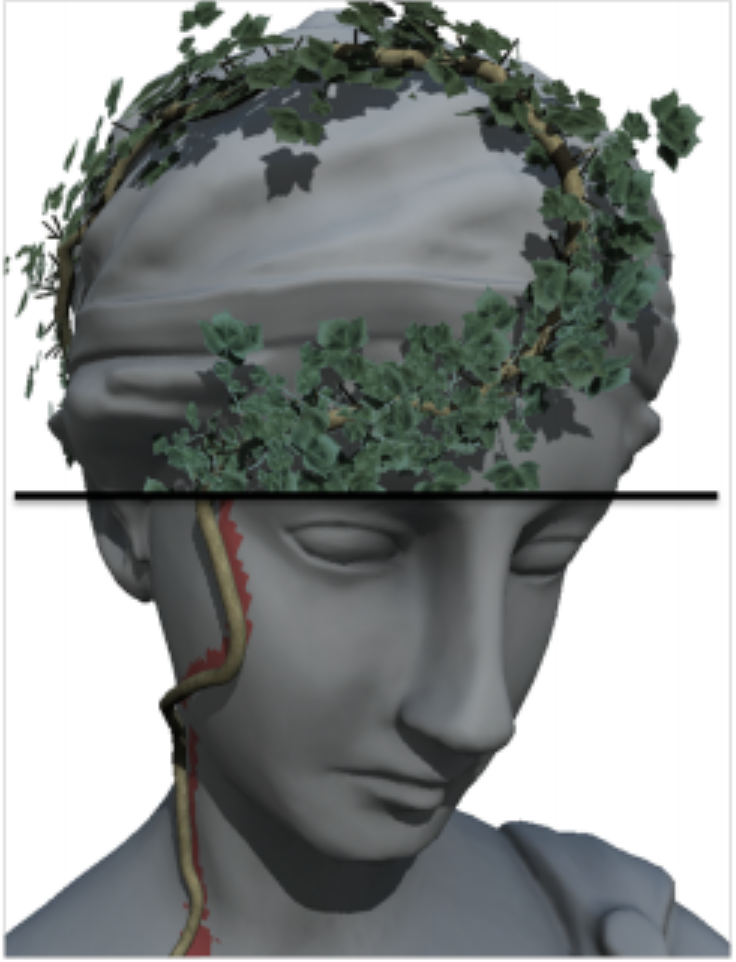Section: New Results
Editing and Modeling
MatCap Decomposition for Dynamic Appearance Manipulation
|
In sculpting software, MatCaps are often used by artists as a simple and efficient way to design appearance. Similar to LitSpheres, they convey material appearance into a single image of a sphere, which can be easily transferred to an individual 3D object. Their main purpose is to capture plausible material appearance without having to specify lighting and material separately. However, this also restricts their usability, since material or lighting cannot later be modified independently. Manipulations as simple as rotating lighting with respect to the view are not possible. In [23] , we show how to decompose a MatCap into a new representation that permits dynamic appearance manipulation. We consider that the material of the depicted sphere acts as a filter in the image, and we introduce an algorithm that estimates a few relevant filter parameters interactively. We show that these parameters are sufficient to convert the input MatCap into our new representation, which enables real-time appearance manipulations through simple image re-filtering operations. This includes lighting rotations, the painting of additional reflections, material variations, selective color changes and silhouette effects that mimic Fresnel or asperity scattering (cf. Figure 11 ).
Dynamic On-Mesh Procedural Generation
|
In collaboration with Technicolor, we developed a method to generate procedural models with global structures, such as growth plants, on existing surfaces at interactive time [18] . Our approach extends shape grammars to enable context-sensitive procedural generation on the GPU. To this end, we unified the representation of external contexts as texture maps, which can be spatially varying parameters controlling the grammar expansion through very fast texture fetches (e.g., a density map). External contexts also include the shape of the underlying surface itself that we represent as a texture atlas of geometry images. Extrusion along the surface is then performed by a marching rule working in texture space using indirection pointers. We also introduce a lightweight deformation mechanism of the generated geometry maintaining a C1 continuity between the terminal primitives while taking into account the shape and trajectory variations. Our method is entirely implemented on the GPU and it allows to dynamically generate highly detailed models on surfaces at interactive time (cf. Figure 12 ). Finally, by combining marching rules and generic contexts, users can easily guide the growing process by directly painting on the surface with a live feedback of the generated model. This provides friendly editing in production environments.
Boolean on general 3D meshes
Computing Boolean operations (Booleans) of 3D polyhedra/meshes is a basic and essential task in many domains, such as computational geometry, computer-aided design, and constructive solid geometry. Booleans are challenging to compute when dealing with meshes, because of topological changes, geometric degeneracies, etc. Most prior art techniques either suffer from robustness issues, deal with a restricted class of input/output meshes, or provide only approximate results.
We overcome these limitations and introduced an exact and robust approach performing on general surface meshes (closed and orientable) [11] . Our method is based on a few geometric and topological predicates that allow to handle all input/output cases considered as degenerate in existing solutions, such as voids, non-manifold, disconnected, and unbounded meshes, and to robustly deal with special input configurations. Our experimentation showed that our more general approach is also more robust and more efficient than Maya’s implementation (
During this work, we also developed a complete benchmark intended to validate Boolean algorithms under relevant and challenging scenarios, and we successfully ascertain both our algorithm and implementation with it.
Extending MLS surfaces
Moving least squares (MLS) surface approximation is a popular tool for the processing and reconstruction of non-structured and noisy point clouds. We introduce [14] a new variant improving the approximation quality when the underlying surface is assumed to be locally developable, which is often the case in point clouds coming from the acquisition of manufactured objects. Our approach follows Levin's classical MLS procedure: the point cloud is locally approximated by a bivariate quadratic polynomial height-field defined in a local tangent frame. The a priori developability knowledge is introduced by constraining the fitted poly-nomials to have a zero-Gaussian curvature leading to the actual fit of so-called parabolic cylinders. When the local developability assumption cannot be made unambiguously, our fitted parabolic cylinders seamlessly degenerate to linear approximations. We show that our novel MLS kernel reconstructs more locally-developable surfaces than previous MLS methods while being faithful to the data.




